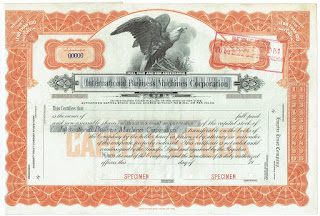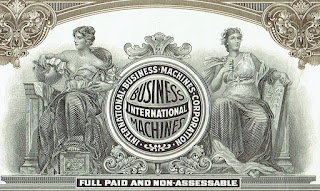More than 6,000 patents in 2012
International Business Machines Corporation (IBM) is an American multinational involved in areas ranging from mainframe computers to nanotechnology. Over the past 100 years, the company invented the hard disk drive, the automated teller machine (ATM), the magnetic stripe card, the relational database, and lots more. Deep Blue, IBM's chess computer defeated world champion Garry Kasparov in 1997. In 2012 the company counted worldwide 435,000 employees. But IBM .. was not always IBM.
 |
| International Business Machines Corporation Certificate for less than 100 shares, issued 1946 Printed by American Bank Note Co. Similar certificates have been printed by Quayle & Son as well. |
Before IBM was IBM
Before IBM went by that name, the company was called the Computing-Tabulating-Recording Company (CTR). CTR was formed in 1911 as a merger of four companies : Tabulating Machine Company, International Time Recording Company, Computing Scale Company of America and the Bundy Manufacturing Company. These companies manufactured a wide range of products, including employee time-keeping systems, weighing scales, automatic meat slicers, and punch-card tabulating machines. The latter category, which allowed the assembly of data and preparation of statistics in the era before computers, turned IBM into the multinational that we know today.
 |
| Facsimile signature of Thomas John Watson (Feb 17, 1874 – Jun 19, 1956) detail from the share certificate above |
Machines for doing business
Thomas J. Watson, formerly a salesman from the National Cash Register Company, joined CTR in 1914 as General Manager. When Watson became CEO in 1924 he changed the company's name into International Business Machines. At that time the four founding companies were still operating as individual operating companies and CTR was only the holding company. Only in 1933 all four businesses were integrated into one company. The name International Business Machines was already used by CTR's Canadian subsidiary, the International Business Machines Co Ltd, founded in 1917. Adopting this new name was making a bold statement : We make machines for doing business ! Computers were not invented yet, so what could have been the meaning of a "business machine" ? How more abstract can a name be ?
 |
| This printer specimen from the American Bank Note Co is one of the first certificates bearing IBM's current name. |
Renaming the company .. and its shares
The printer specimen, illustrated just up here, was printed before Watson decided to give the company its new name in February 1924. The certificate is one of the first ones mentioning the new company name. The original company name, Computing-Tabulating-Recording Co, was printed on the certificate, but it was relabeled with a silver overprint. I included a detail of the name, scanned at 600 dots per inch, where you can distinguish 'TABULATING' in the background.
Also the denomination of the certificate was altered. Originally SHARES $100 EACH was printed just below both sides of the company name, but also that was overprinted with silver. In the main body text, another stripe of silver, overlapping the initial denomination, now tells us that the shares are without nominal or par value. Just double-click the images to see these details.
Into the world of digital computers
World War II marked a new era. The transition from mechanical and electromechanical office equipment to modern computers was not an easy one. In the 1940s IBM experimented with huge and costly digital computers such as the Harvard Mark I and the Selective Sequence Electronic Calculator. During this period Watson did not fully recognize the potential of digital computers. In 1947, after 22 years, IBM changes its logo again. The familiar "globe" was replaced with the simple letters "IBM" in a typeface called Beton Bold. At first, it looked like the company would loose market share to its punched-card equipment competitor Remington Rand who, after taking over the Eckert-Mauchly Computer Corporation, succesfully marketed their line of Univac computers. However, IBM regained gradually ground after bringing to the market their first mainframe computers such as the Card-Programmed Electronic Calculator, the IBM 701 Defense Calculator and their Model 650 Magnetic Drum Data-Processing Machine.
 |
| Compagnie IBM France When IBM launched in 1953 Model 650, the world's first mass-produced computer, IBM France conceived the word ordinateur which became the common French word for computer. detail from the certificate at the bottom of the article |
Digital electronic computing is the way to go
In May 1956, shortly before Thomas Watson dies, Thomas Watson Jr. succeeds his father as Chief Executive. Unlike his father, he strongly believed in the future of digital (*) electronic computers. The company introduced a subtle change in the company's logo. This time, the letters "IBM" looked more solid and balanced. IBM was determined to guide their customers into a new digital world smoothly. An example of that logo is show in the image just above.
(*) Electronics deal with electrical circuits, where Digital Electronics refer to electronic circuits which operate by signals using digits, mostly binary digits (zeros and ones).
(*) Electronics deal with electrical circuits, where Digital Electronics refer to electronic circuits which operate by signals using digits, mostly binary digits (zeros and ones).
 |
| Facsimile signature of Thomas John Watson Jr. (Jan 14, 1914 – Dec 31, 1993) detail from the share certificate below |
Thomas Watson Jr. redirected the company towards a dominating position in the computer market. He pushed breakthrough developments such as the IBM 701 in the 1950s and the IBM System/360 in the 1960s. When he became CEO in 1956, IBM employed 72,500 people and had a gross income of $892 million. When he stepped down in 1971, employees numbered more than 270,000 and gross revenue was $8.3 billion.
 |
| International Business Machines Corporation Certificate for shares of $5, isued 1966 Printed in black and violet by the Security-Columbian Banknote Company |
References
- IBM and his logo's
- IBM's chairmen
- .. and lots of Wikipedia
There is some much more to tell about IBM in the computing age, but that is for another post.




More on IBM and scripophily can be seen there :
ReplyDeletehttp://ismoc.blogspot.be/p/organizations.html